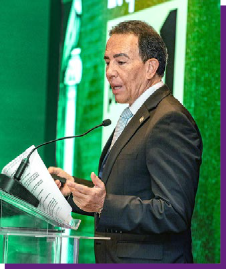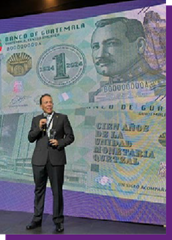



At the recent HSP™ Latin America conference in Rio, the winner of the Regional Commemorative Banknote of the Year award was Banco de Guatemala (Banguat) for the Q1 quetzal. The Governor, Alvaro González Ricci, who received the award, also spoke about the banknote in his presentation at the conference.
What stood out in this presentation was that – beyond the note’s visual and security features – its main purpose was to communicate to Guatemalans the strength of the central bank and the national economy, both serving as a beacon of stability in the region.
Currency News™ caught up with Alvaro González Ricci, following his receipt of the award to find out more.

Q: Firstly, could you tell us a little about your background and how you came to join Banguat?
A: I began my career in the banking sector, where I gained twenty years of experience. In 2007, a friend persuaded me to enter politics, and together we founded the political party CREO. I was also elected as a member of the Guatemalan Congress from 2012 to 2016, representing Guatemala City. After that I was an advisor to the Presidency in Congress in 2017.
I then became a consultant for the IDB (International Development Bank) and later, also a consultant for the World Bank in Guatemala.
After that, the former President of Guatemala, Alejandro Giammattei (from 2020-2024), with whom I was acquainted when we were both working at the Banco del Café in the 1990s, invited me to join his movement. I considered this invitation and I agreed to be part of his election team working on his campaign. When Mr Giammattei was elected president, I was appointed Minister of Finance, a position I held for almost three years, from 2020 to 30 September 2022.
Following that position, I was appointed by the President to my current role as President of Banco de Guatemala. I have been in this position from 1 October 2022 to date and will continue to do so until the term ends on 30 September 2026.
Q: What is the current cash environment in Guatemala?
A: Cash is still king in Guatemala. In Europe, electronic payments are dominant, but in Latin America cash is still the most widely used method of payment. Therefore, cash in circulation continues to grow.
However, there is full awareness that we are moving forward to the digital world.
In Guatemala we are currently trying to pass a law that regulates electronic means of payment, as we are one of the few countries that do not have such a law regarding fintech companies and wallets.
There is also an initiative in Congress, which Banco de Guatemala has been invited to participate in, to seek a regulation on the issue of cryptocurrencies and crypto-assets that would be legal tender.
Even though it is true that the country is cash-driven, we are being very active in going towards where the market is going, and that clearly is to more digital markets.
Q: Is Banguat still focused on ensuring that people have access to cash?
A: We are committed to ensuring that both cash and electronic payment systems works effectively. In Guatemala, and I would say in most countries, there is a fear of leaving cash.
Central banks have to be very careful with CBDCs – which are yet to be adopted – because people fear that by having all their money fully registered digitally, the central banks could intervene and potentially devalue it.
Another fear of full electronic currency is that the government or central banks can regulate where and how you spend your money. There is a lot of informal economy in Guatemala, like many others in South and Central America. This informality means that many people who currently don’t pay income tax, for example, fear that when they go digital, they can be fully traced. They are afraid that they will be forced to become part of the formal sector, with the accompanying traceability – which many low-income individuals fear will involve expenses for them that will not be met, given their current wages.
Q: The quetzal has remained very stable against the US dollar in recent years, in addition to Guatemala’s sovereign credit rating being recently upgraded. Could you expand a little on this, and what Banguat has been doing right?
A: The quetzal is among the most stable currencies worldwide. Kristalina Georgieva, Managing Director of the IMF, has even described Guatemala as a ‘bright spot in the region’, recognising our macroeconomic stability over the past two decades. During this period, our exchange rate has remained consistently around Q7.70 quetzales per dollar.
GDP has grown by an average of 3.5% in recent years, more than many other countries in the region. Our target GDP growth is 4% but the US administration’s tariff policy will affect this, particularly as they are our largest trading partner. So this target could be closer to 3.8% as a result. Although we are the first country in the region to reach stability targets, which builds confidence in our economy.
Standard & Poor’s has raised Guatemala’s credit rating to BB+, placing the country just one notch below investment grade.
As Minister of Finance, I was always concerned with our credit rating and I decided to build up a good communication strategy where we worked closely with banks, exporters, our Tax Authority (SAT), and so on, and visited all the rating agencies to move forward.
Today, as President of Banco de Guatemala, I cannot be happier that a goal I had as Minister of Finance has rendered positive results with the new BB+ rating.
And I hope that our sovereign debt rating will be improved further still. At least, that is one of my hopes for the remainder of my term.
Q: Congratulations on winning the Best Commemorative Banknote. Can you describe the winning banknote and the background to its release?
A: The quetzal currency was launched in 1924, over 100 years ago, and the commemorative banknote reflects the stability of the currency. The last Q1 quetzal banknote was printed in 2012, but the denomination was chosen for the commemorative note due to its historical significance.
The quetzal bird has a red-breasted (which is the national bird of Guatemala and after which the currency is named) that represents the death of a Mayan warrior, Tecun Umán, who was killed during the Spanish conquest.
The quetzal flew and rested on the warrior’s chest and the quetzal’s breast turned red.
Giesecke+Devrient printed the banknote, which features two lines of intaglio print for the visually impaired, perfect registration on the flag, and a varifeye® ColourChange security patch. The creation of this banknote was a team effort between Banguat and Giesecke+Devrient, who worked closely together.

Q: How was the banknote received by the public?
A: By law, the Banguat must be able to exchange any amount of money in any of the different denominations upon request.
In this case, we had to open 10 additional bank tellers in our building due to the popularity of the Q1 quetzal banknote. It was like waiting in line at Disneyland!
This banknote may represent all of the cultural highlights of the country, but it is also legal tender.
The original note is difficult to find in circulation, so numismatic collectors are also interested in collecting it.
When the banknote was launched on 10 September 2024, the central message, in addition to the banknote’s features, was to highlight Banco de Guatemala as the sole issuer of the national currency and the guardian of monetary stability in the country.
We were able to take advantage of the public and media interest in the Q1 quetzal note to really promote the role and cultural/ societal initiatives of Banco de Guatemala. We have an app, ‘Billetes GT’ (Banknotes of Guatemala), that can be used to learn about all the banknotes of Guatemala and the current series characteristics, for example.
We estimate that the value of the publicity that we received is at least as much as the cost of producing the 25 million banknotes. The banknote, its design, and security features, has served to position the Bank more positively and allowed it to have even more communication benefits in the subsequent six months.
Q: The current banknotes series dates back to c. 2008, whilst the fundamental designs date back to the 1980s. Are there plans for a change any time soon?
A: We are analysing designs for a new family, but any changes will have to go through Congress, which is likely to take some time. I do like banknotes that use nature (flora and fauna) in their designs rather than politicians, but I am not sure if this will happen.
Both Congress and the central bank need to be aligned if creating a new series is an objective for both the administration and the central bank.
Q: HSP LatAm came to Guatemala in 2017 and is planning to return in 2026. What message do you have to the industry, and why should they visit your country?
A: We would love to show our country to those who decide to visit. We want to promote Guatemala to everyone, so they can experience beautiful places like Antigua Guatemala, Lake Atitlán, the Petén ruins, and even enjoy experiences like volcanic tourism, which is now very popular and unique in the country.
For the industry, it is essential that central banks use their banknotes as a communication tool with the population, and the Q1 quetzal banknote has been a great success for us in this regard.
